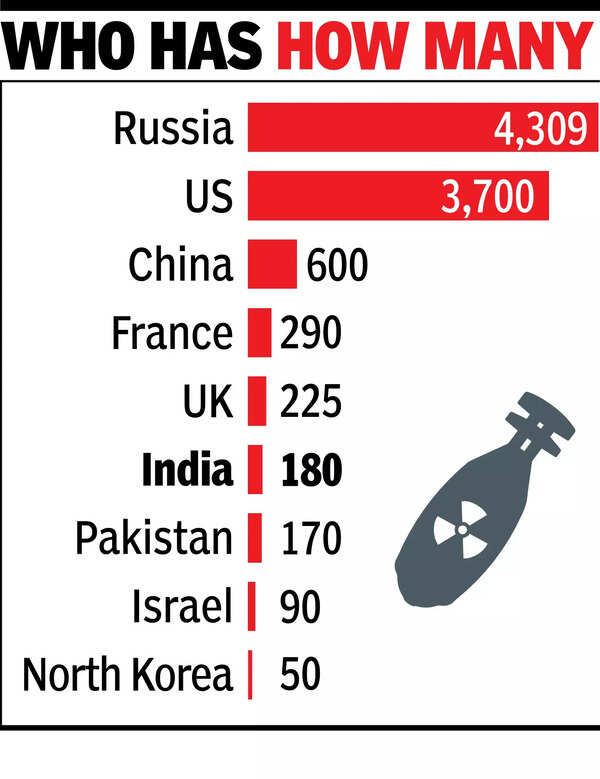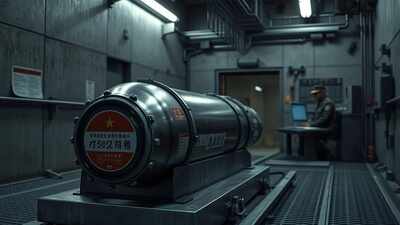China adding 100 nuclear warheads annually: SIPRI | India News

NEW DELHI: China is now adding 100 warheads to its nuclear arsenal every year, which is already more than three times India’s stockpile. While India continues to maintain a slight edge over Pakistan, the recent cross-border military conflict between them risked escalating into a nuclear crisis, says a global arms watchdog.China has 600 warheads, up from 500 in Jan 2024, while India has 180 and Pakistan 170, as per the latest assessment by the Stockholm International Peace Institute (SIPRI) released on Monday. Russia and the US, of course, are way ahead of others, together accounting for 90% of all nuclear weapons.Taking note of Operation Sindoor launched by India against Pakistan on May 7, a senior SIPRI researcher said, “The combination of strikes on nuclear-related military infrastructure and third-party disinformation risked turning a conventional conflict into a nuclear crisis.”Indian officials, including Chief of Defence Staff General Anil Chauhan, however, have stressed that the May 7-10 hostilities came nowhere close to either side contemplating the use of nuclear weapons.

India, however, did strike the Sargodha and Nur Khan air-bases, among others, in clear strategic messaging. The first is located near Pakistan’s underground nuclear infrastructure and storage facilities at Kirana Hills, while the second is close to the headquarters of the Strategic Plans Division that oversees the country’s nuclear arsenal.The SIPRI researcher, on his part, said, “As the recent flare-up of hostilities in India and Pakistan amply demonstrated, nuclear weapons do not prevent conflict. They also come with immense risks of escalation and catastrophic miscalculation – particularly when disinformation is rife – and may end up making a country’s population less safe, not more.”Overall, the SIPRI report said China’s nuclear arsenal is growing faster than any other country and is likely to touch 1,500 warheads by 2035. Both India and Pakistan continued to develop new types of nuclear weapon delivery systems in 2024, and are also pursuing the capability to deploy multiple warheads on ballistic missiles.India has “slightly expanded” its nuclear arsenal from 172 warheads last year to 180 now, with its new “canisterised” missiles making it possible for them to carry mated nuclear warheads even during “peacetime”, it added.As reported by TOI earlier, the China-specific Agni-5 (strike range over 5,000 km) and the new-generation Agni-Prime (1,000-2,000 km) ballistic missiles, which are being inducted into the Strategic Forces Command (SFC), come in hermetically-sealed canisters. The Agni-Prime will gradually replace the Agni-1 (700 km) and Agni-2 (2,000 km) missiles already in the SFC’s arsenal.With missiles with mated warheads in ready-to-fire configurations, the SFC gets the requisite operational flexibility to store them for long periods, swiftly transport them through rail or road when required, and fire from wherever they want. The Agni-5 was also tested with multiple warheads (MIRVs or multiple independently targetable reentry vehicles) for the first time in March last year.The SIPRI report said Pakistan is developing its “nascent” nuclear triad of aircraft, ground-launched ballistic and cruise missiles, and sea-launched cruise missiles like the Babur-3 being fitted on Agosta-90B diesel-electric submarines.India, in turn, has a “maturing” nuclear triad, with two operational SSBNs (nuclear-powered submarines armed with nuclear ballistic missiles) in INS Arihant and INS Arighaat, strengthening the naval leg of its nuclear triad. The third slightly larger SSBN will be commissioned as INS Aridhaman this year, as reported by TOI earlier.





